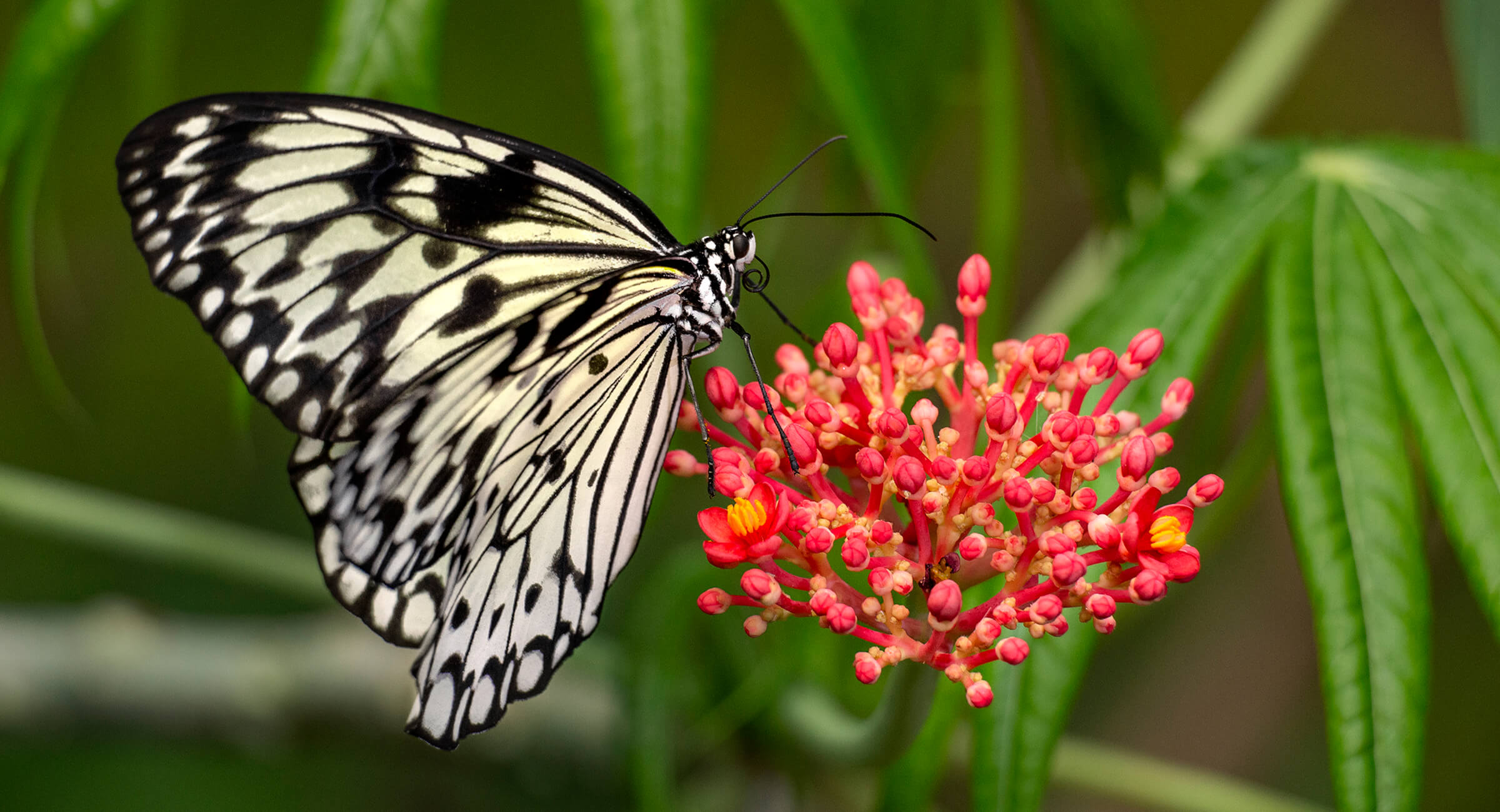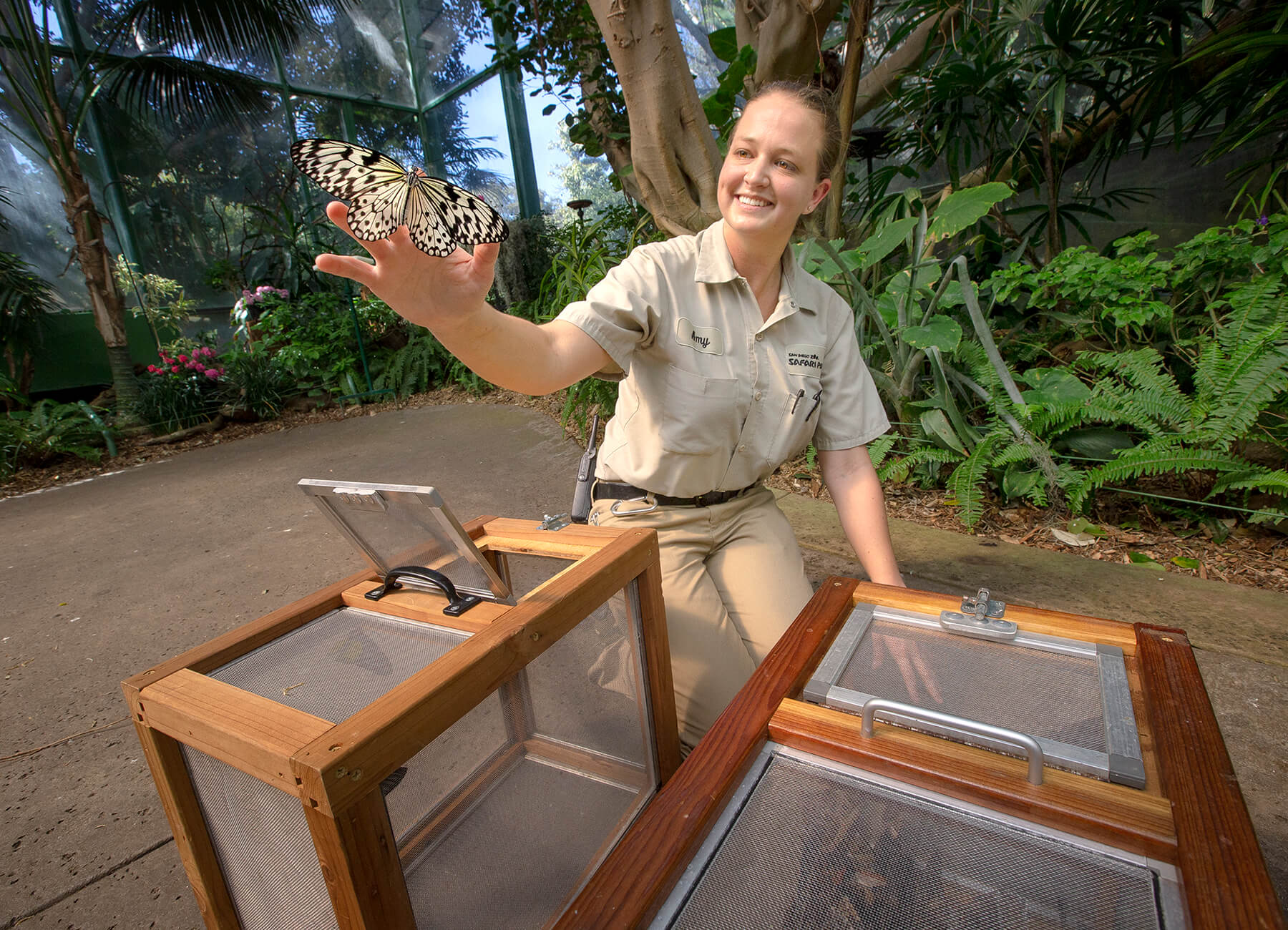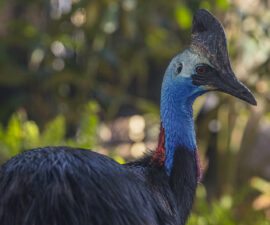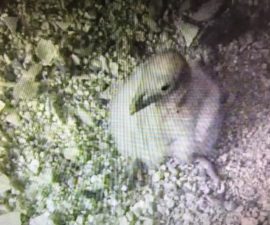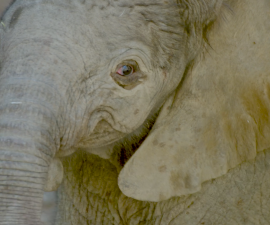BY Donna Parham
Photography by Ken Bohn
Each spring, the Safari Park’s Hidden Jungle aviary is transformed into Butterfly Jungle, an enchanted habitat that elicits “ooohs” and “ahhhs,” camera clicks, and gleeful grins. Creating the immersive, awe-inspiring ballet of color and activity requires cooperation, ingenuity, detailed focus, and hard work. Team members from many departments pitch in to create the magic. Here’s a behind-the-scenes look.
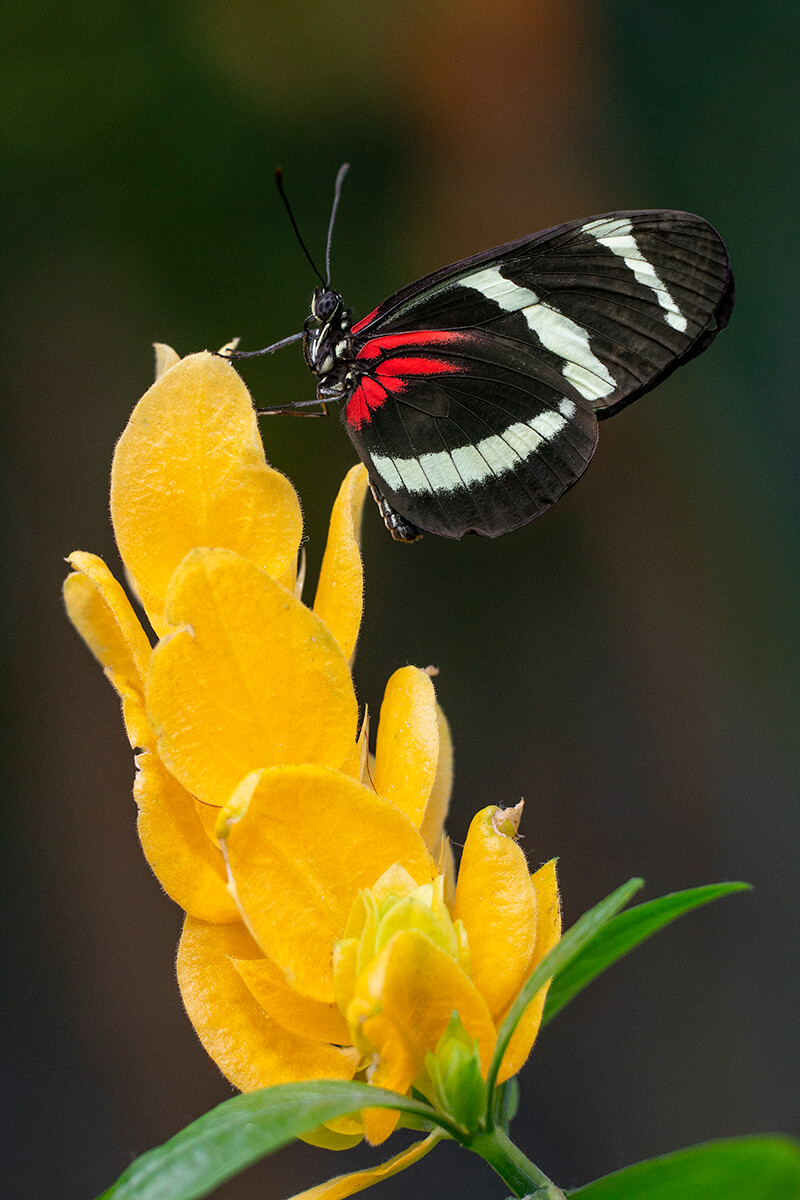
REST STOP
A Hewitson’s longwing Heliconius hewitsoni perches atop a Pachystachus bloom in Butterfly Jungle.
Before a single butterfly takes wing or a single bloom unfurls, there’s paperwork. The 12-page permit from the USDA is the first clue that displaying exotic butterflies is no simple endeavor. It lists more than 140 species of permitted butterflies and spells out species that are not permitted. It establishes requirements for training and staffing, and describes protocol for containing exotic species while prohibiting their reproduction. It lists approved plant materials, and details how to inspect pupae (chrysalises) and how to dispose of plant material and other waste from the contained area. Whew!
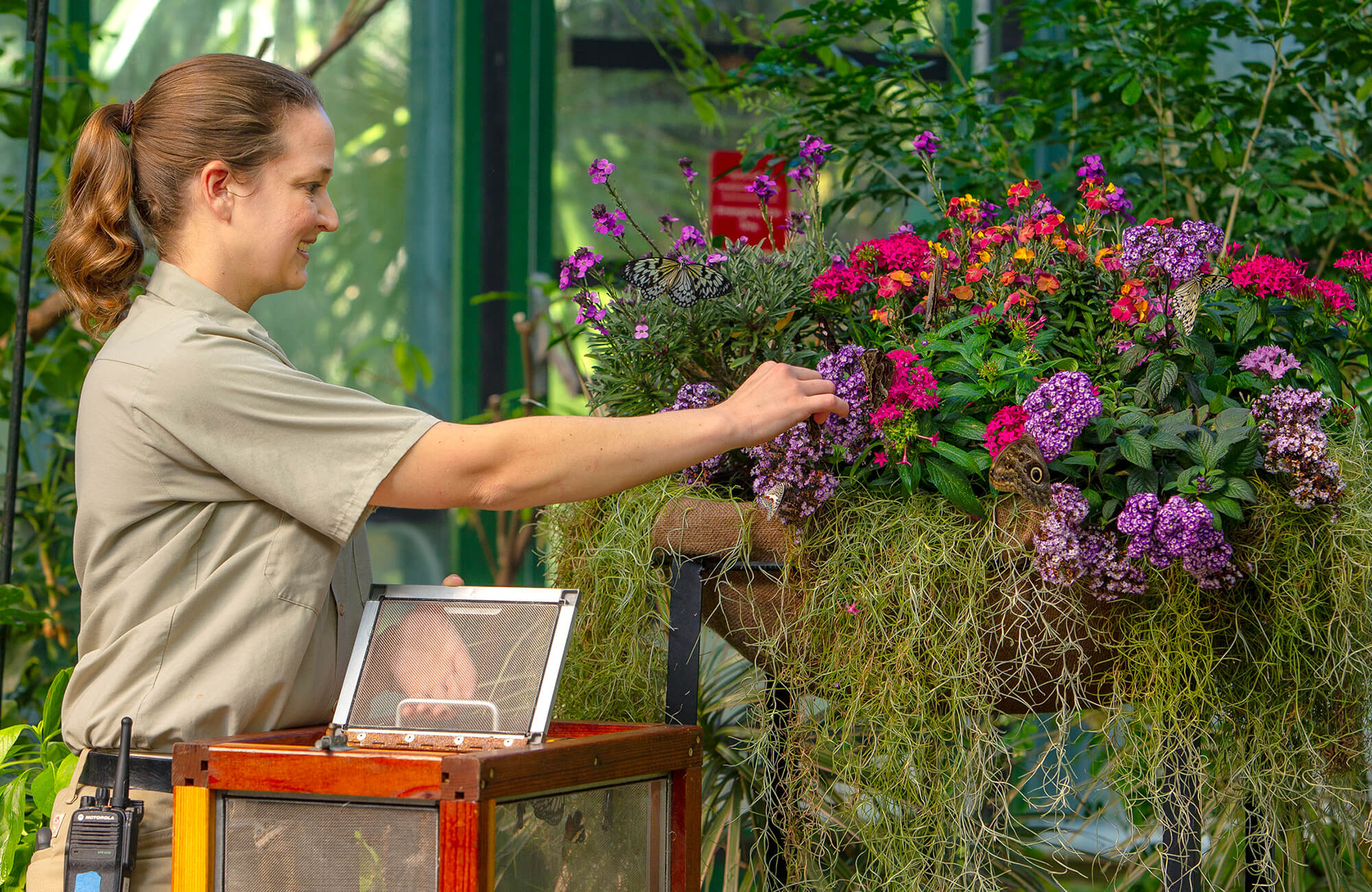
CREATING BUTTERFLY HABITAT
A lot of activity happens inside Butterfly Jungle before the first butterfly of the season is ever released.
Safari Park workers do year-round maintenance and inspection, but “about a month before the opening, a specialist climbs up to inspect the roof and windows,” says Mark Loigman, director of facilities. “To prevent any escapes, we have to assure the integrity of the outside envelope.” To that end, his team has constructed an exit vestibule and installed blowers at the top of doors to discourage butterflies. They also inspect the pupae room for containment and temperature control. It means extra work, but as Mark says, “Butterfly Jungle is a special sort of thing.”
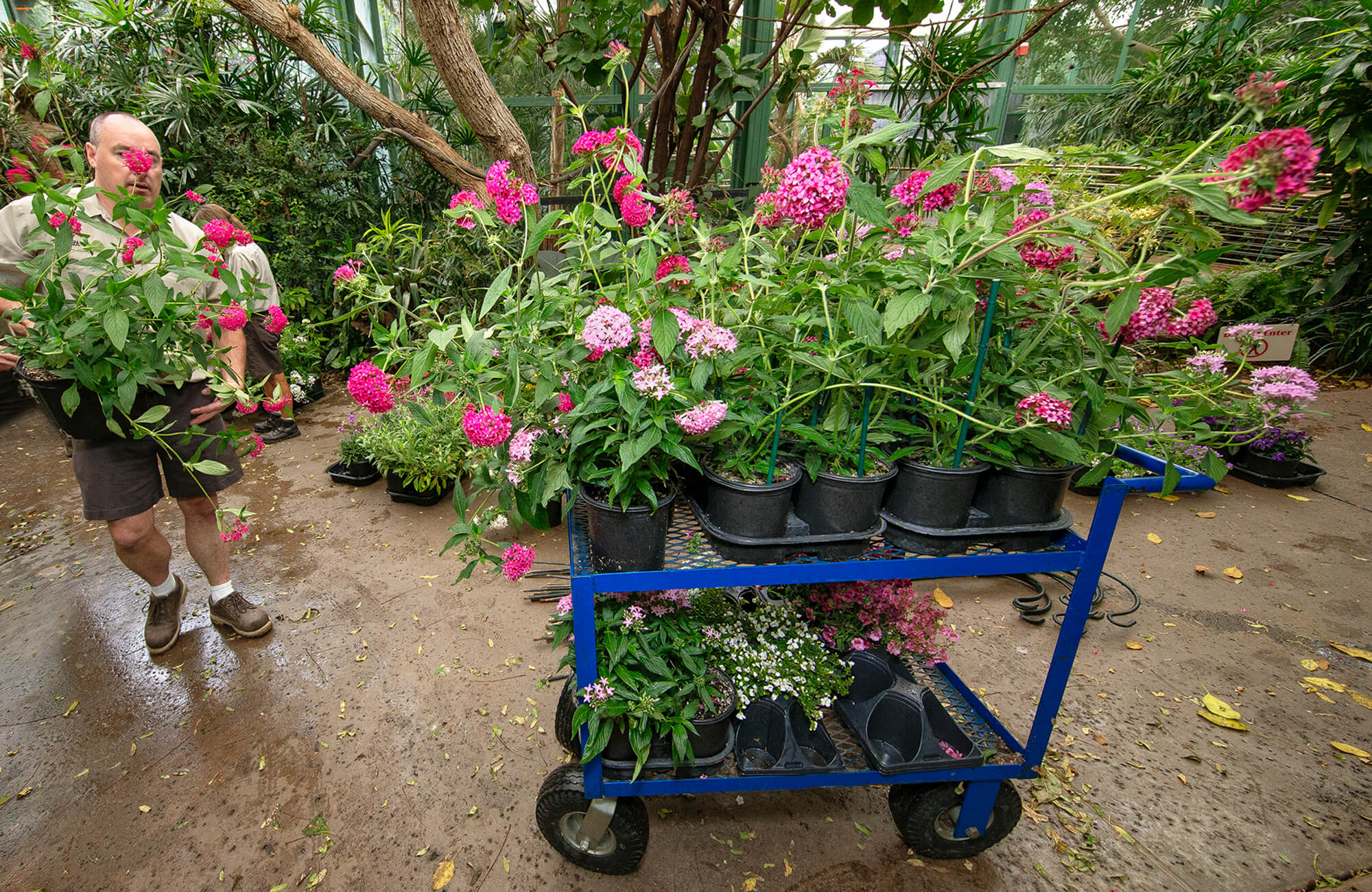
GILDING THE LILY
To have the habitat ready for butterflies, Park horticulturists begin installing flowering plants as soon as the first shipment of butterfly pupae arrive. The aviary is already a lush, tropical habitat, but the horticulture team tucks enticing, colorful blooms into nectar stands and hanging baskets strategically placed throughout the aviary. “We consider what the experience will be for visitors, and spread out the flowers,” says Keith Thomas, lead horticulturist. “We make sure that there are some places on the pathway where visitors can stand behind flowers, so that they can be in the picture with a butterfly.”
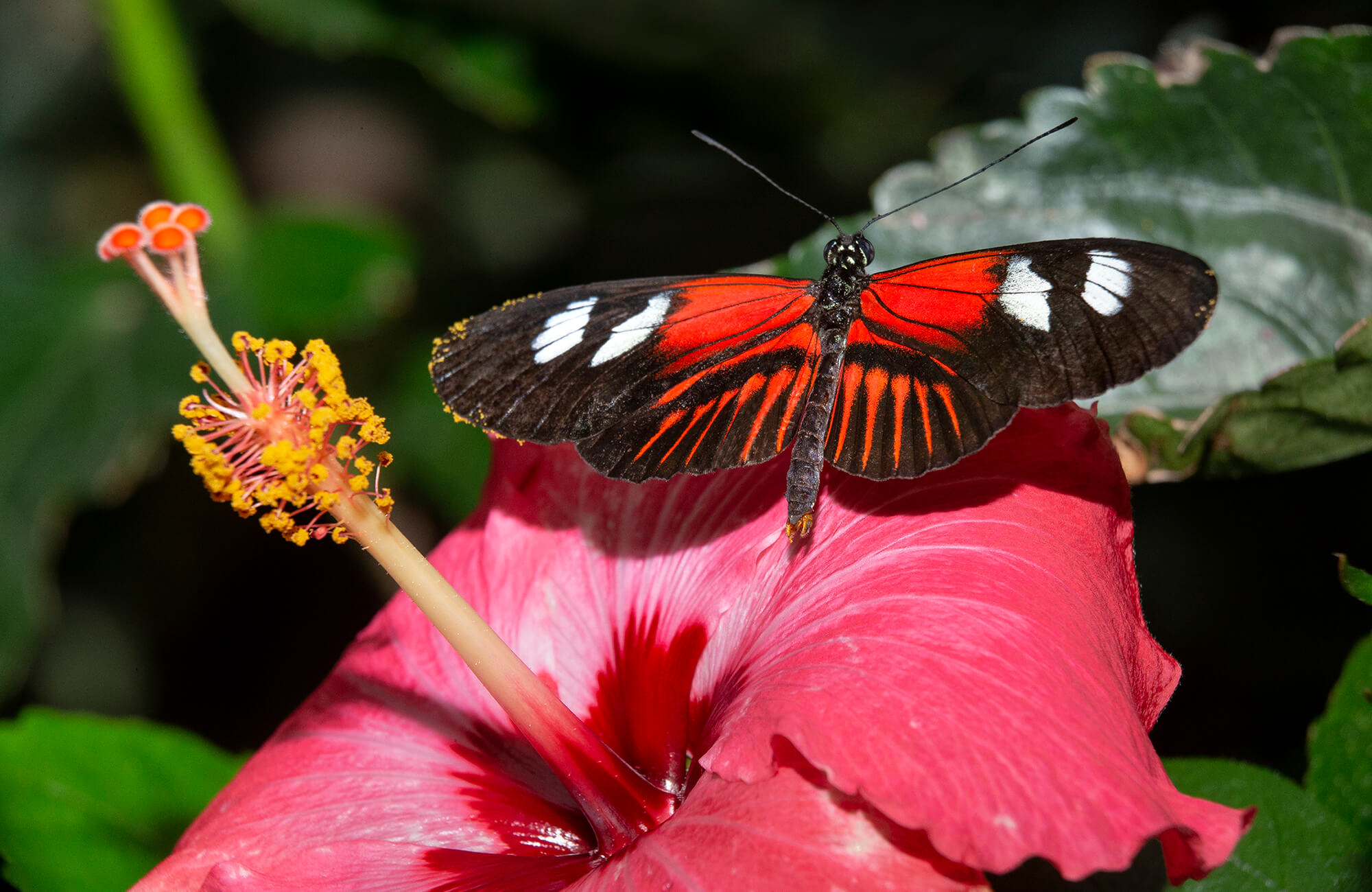
INSTAGRAM-READY
“Everybody wants that perfect, beautiful picture,” says Keith. He says that while hibiscus nectar is too deep for many butterflies to reach, the flower’s wide petals give the winged wonders a good place to stop for a rest—and a post-worthy pic. Here, a Doris longwing Heliconius dorisi butterfly rests on a hibiscus bloom.
Because growers typically stock leafy plants, with some buds and fewer blooms, getting plants in full bloom poses a challenge. About three times a week, Park horticulturists hand select exactly the plants they need, from a half-dozen or so preselected growers. “We want as many flowers as possible,” says Keith. He explains that conditions in the aviary aren’t particularly suited for growing these flowering plants, so they are short-lived displays. But, once the blooms begin to fade or fall, horticulturists quickly replace the plant.
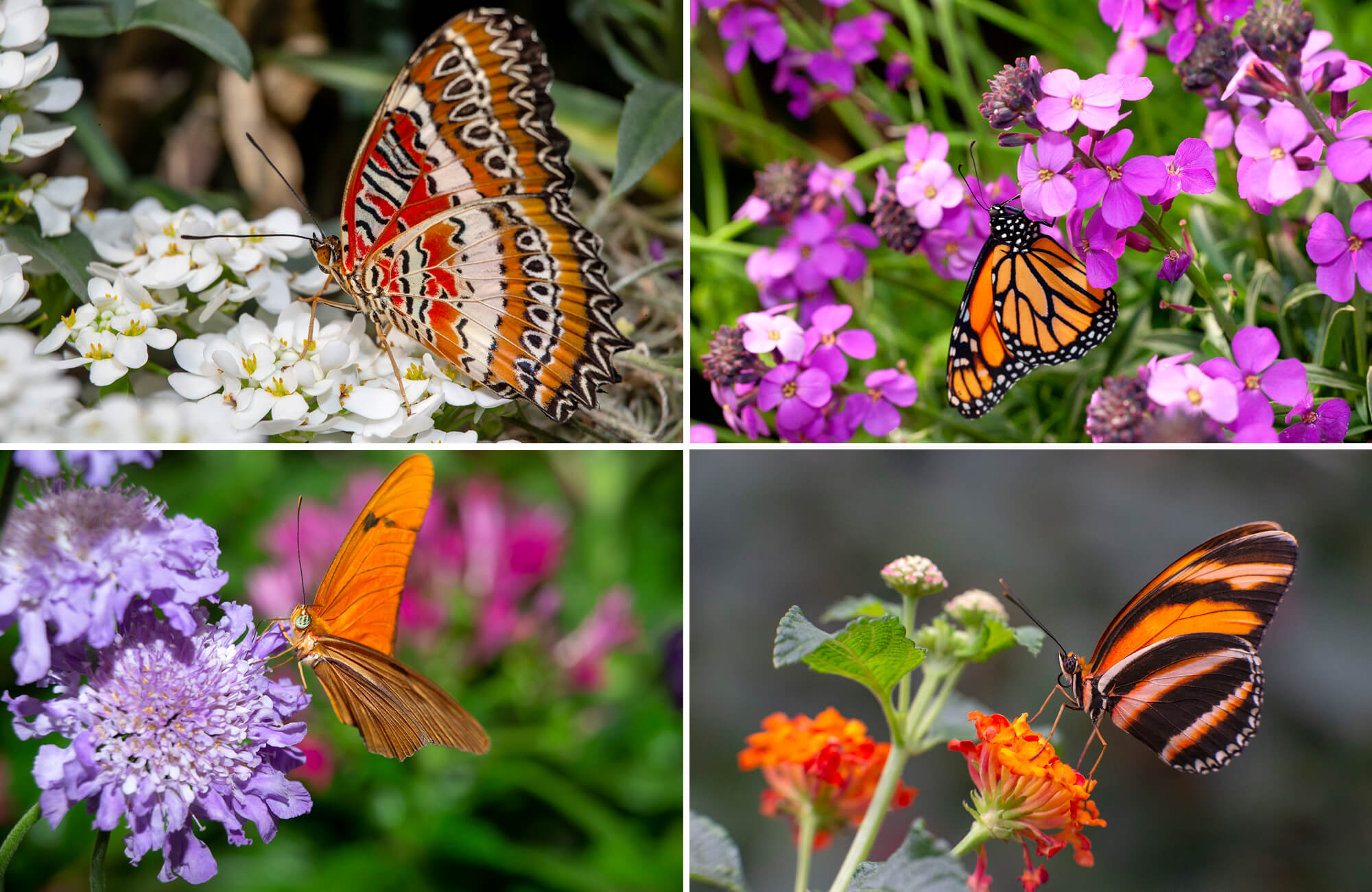
CROWD FAVORITES
Some of the butterflies’ favorite nectar plants include the ones pictured here. (Clockwise from top left): a Cethosia biblis atop an Iberis, a monarch butterfly Danaus plexippus perched on a Verbena, a banded orange butterfly on a Lantana, and a Julia butterfly Dryas iulia on a Scabiosa bloom.
To keep the exhibit looking beautiful—for butterflies and for visitors—five horticulturists install and switch out up to 300 plants every week. “Mondays and Wednesday are touch-up days, and Friday is the big day, so that it looks great for the weekend, when most people visit,” says Keith. The team begins their work as soon as the resident birds in the aviary wake up—at sunrise—and their goal is to be done before visitors arrive at 9 a.m. That means working fast. “Our biggest challenge is the timing: it’s a lot of work during a very short period of time,” says Keith. “Each of us has our own specific tasks. We want to get it looking perfect for our visitors.”
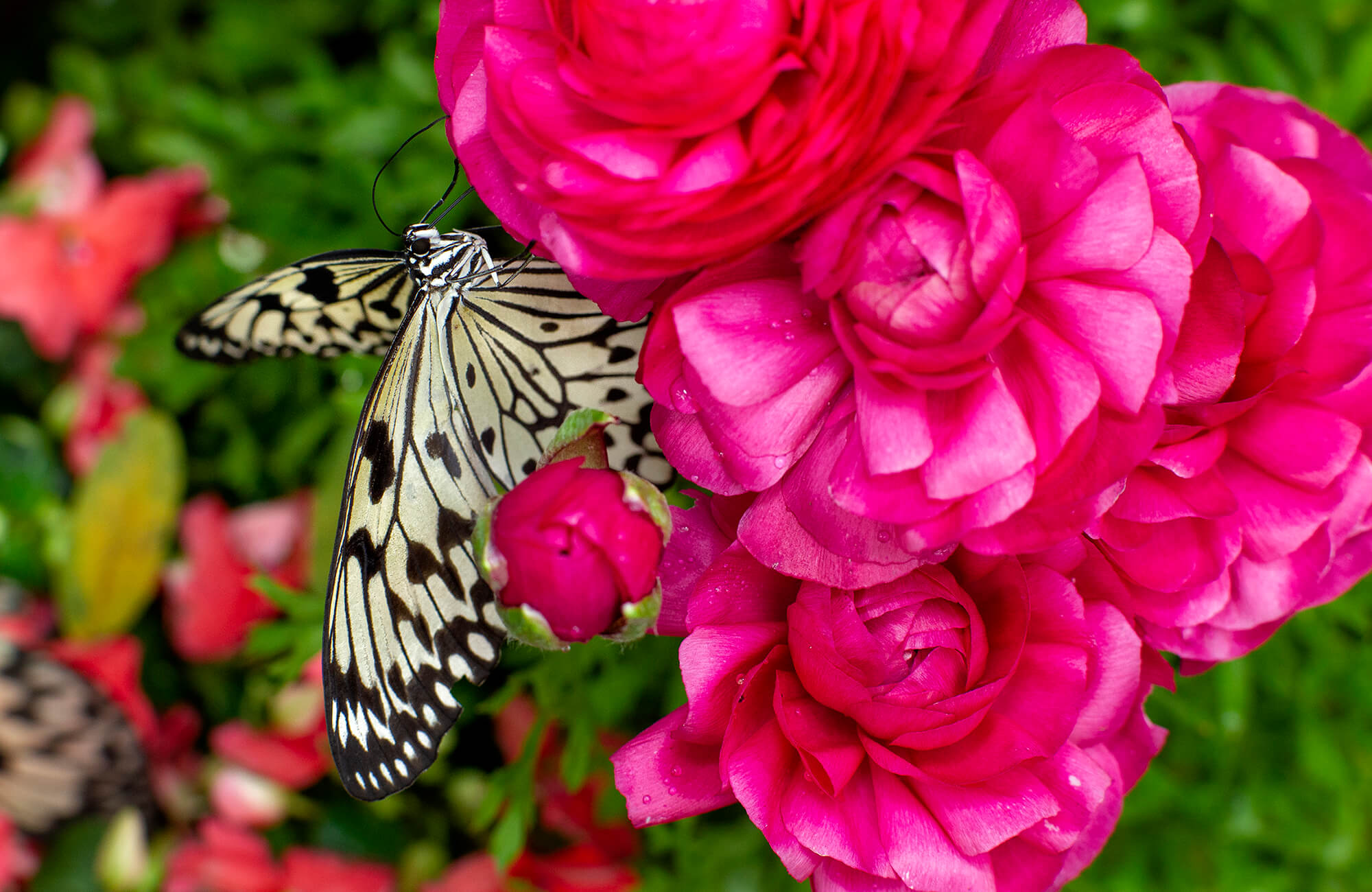
SHOW-STOPPER
Park horticulturists select some flowering plants with guests in mind. The big, bright, solid color blooms of a ranunculus provide a picture-perfect backdrop for this Idea leuconoe butterfly.
An important criterion for plants is that they are not known host plants for butterfly larvae (caterpillars) of the species in the exhibit, because an escapee could pose a threat to native species. Protocol specifies that—because of the slight chance that errant butterflies or larvae may be clinging to the spent plants—all removed plant material must be chopped into two-inch pieces and double bagged. The pot and soil go into a separate, safeguarded waste container. “Containment is huge. It’s especially important here, because of San Diego’s favorable climate, which increases the risk that escaped butterflies might survive and reproduce,” says Keith.
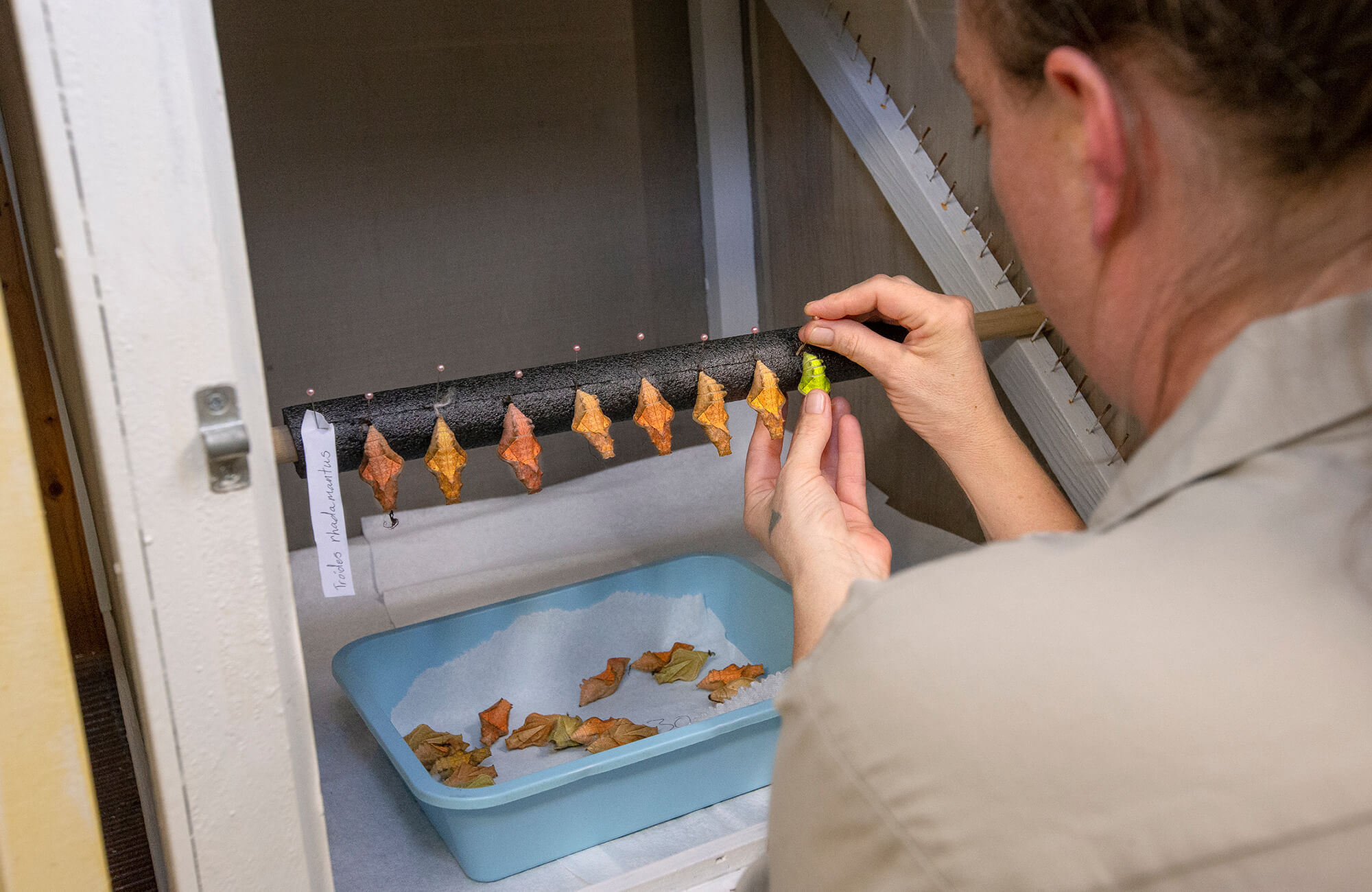
IN A FLUTTER
The bird department is responsible for the butterflies, so they bring on extra staff: four butterfly keepers, three pupae pinners, and nine exhibit attendants. Butterflies arrive in the form of pupae. “The lifespan of these species ranges from about 10 days to more than 6 weeks,” says Andrew Stehly, animal care manager. To make sure that butterflies are abundant in the aviary throughout the 9 weeks of Butterfly Jungle, he arranges for 18 separate shipments—a total of 5,000 pupae.
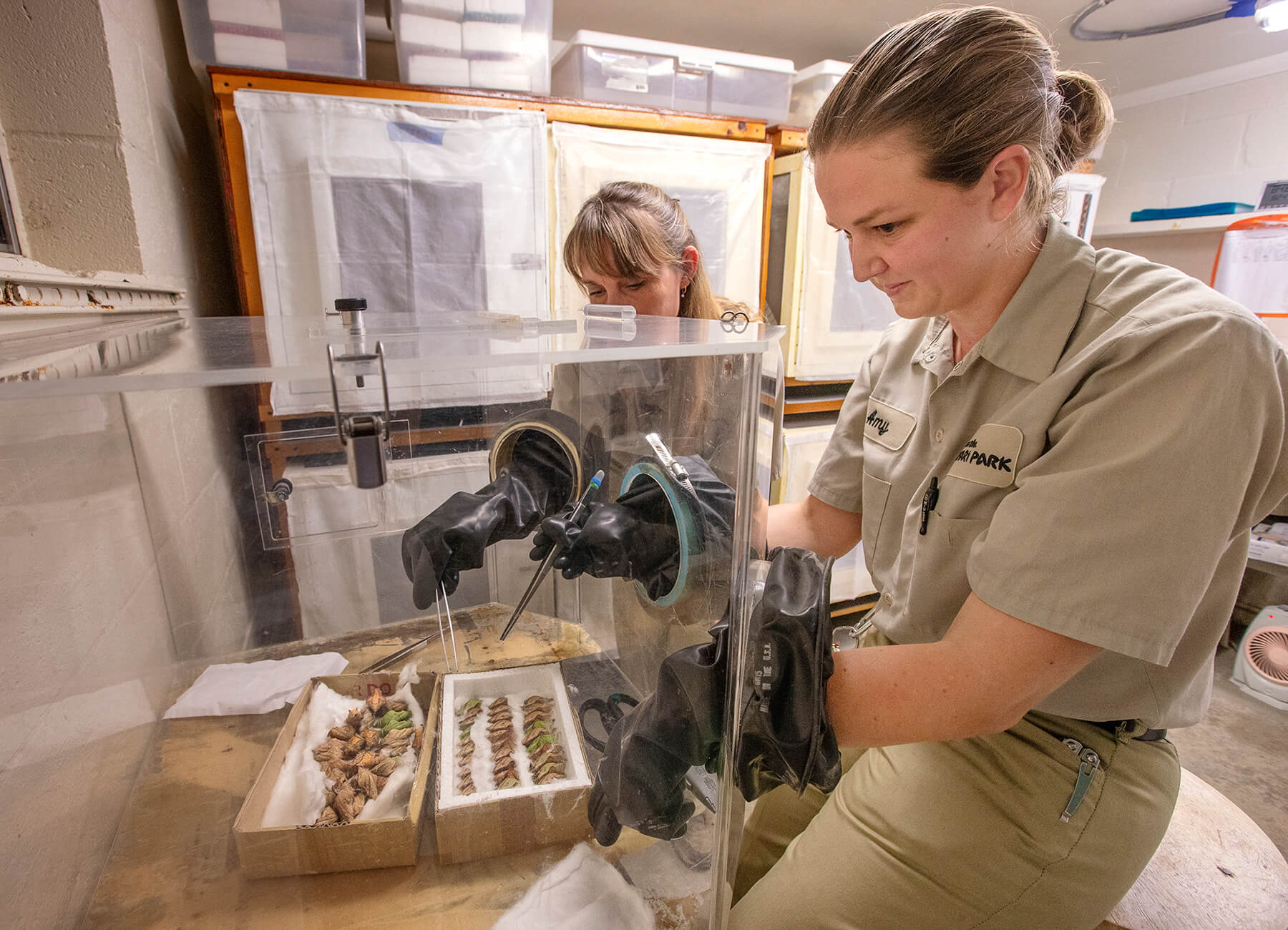
CLOSE INSPECTION
A glovebox is a sealed, isolated containment unit inside the pupae room. Butterfly keepers examine each pupa to safeguard against introducing unwanted species or disease.
Butterflies emerge from their pupae soon after they arrive, so a new delivery swiftly sets the team in motion. Inside the hot (80 degrees Fahrenheit), humid (80 percent) “pupae room,” keepers carefully inspect the pupae shipment, inside a sealed glovebox they call the “unpacking box.” One side of the glovebox is transparent, and gloves are built in so that a keeper can manipulate what is inside. It’s the same kind of box used for handling hazardous material.
“We have to make sure that no parasites are present,” says Marci Rimlinger, lead keeper. “We also have to make sure that the box contains only the species listed on the permit.” Only after that scrutiny do the keepers remove each precious chrysalis. As the pupae are removed, “We count and record the number of each species, and note any smashed or damaged pupae,” she says.
Pupae pinners position the pupae in “emerging boxes,” gently hanging each pupa by its tiny silk stalk, at an appropriate distance apart, so that the newly emerged butterflies have room to spread their wings. Once they are dry, keepers move the emerging boxes into the exhibit, where the butterflies quickly discover an abundance of blooms and nectar.
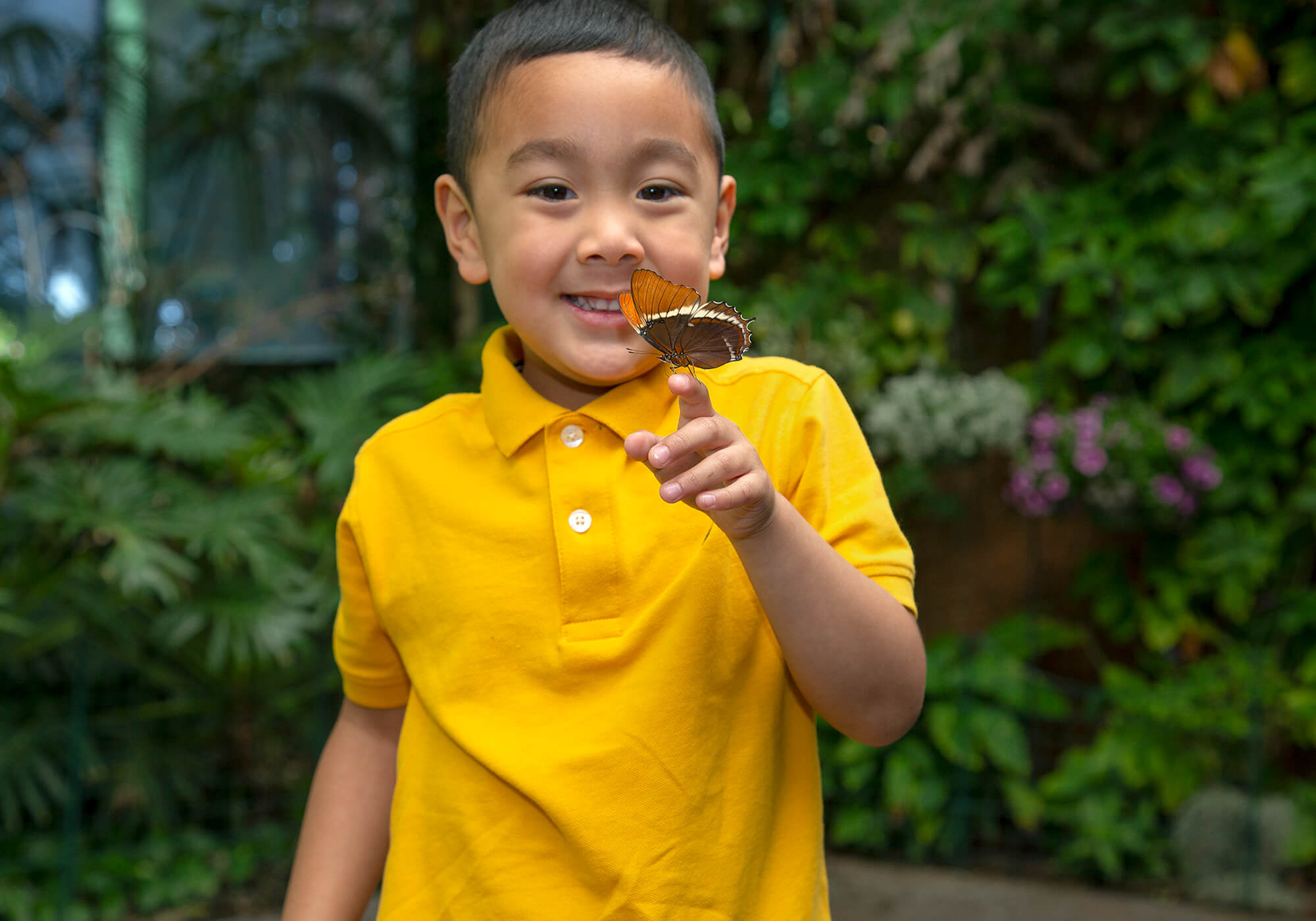
GETTING READY FOR GUESTS
Guest ambassadors from the operations department staff Butterfly Jungle at the queues, at the doors, and at a number of checkpoints inside. “We do a big hiring push in the beginning of the year, bringing on an additional 40 to 50 people,” says Josie Murphy, operations supervisor. She admits that hiring and training temporary staff is an annual challenge, but “the goal is to make sure guests have a great experience—and don’t leave with any hitchhiking butterflies,” she says. “We are responsible for thousands of people coming through, and thousands of butterflies inside.”
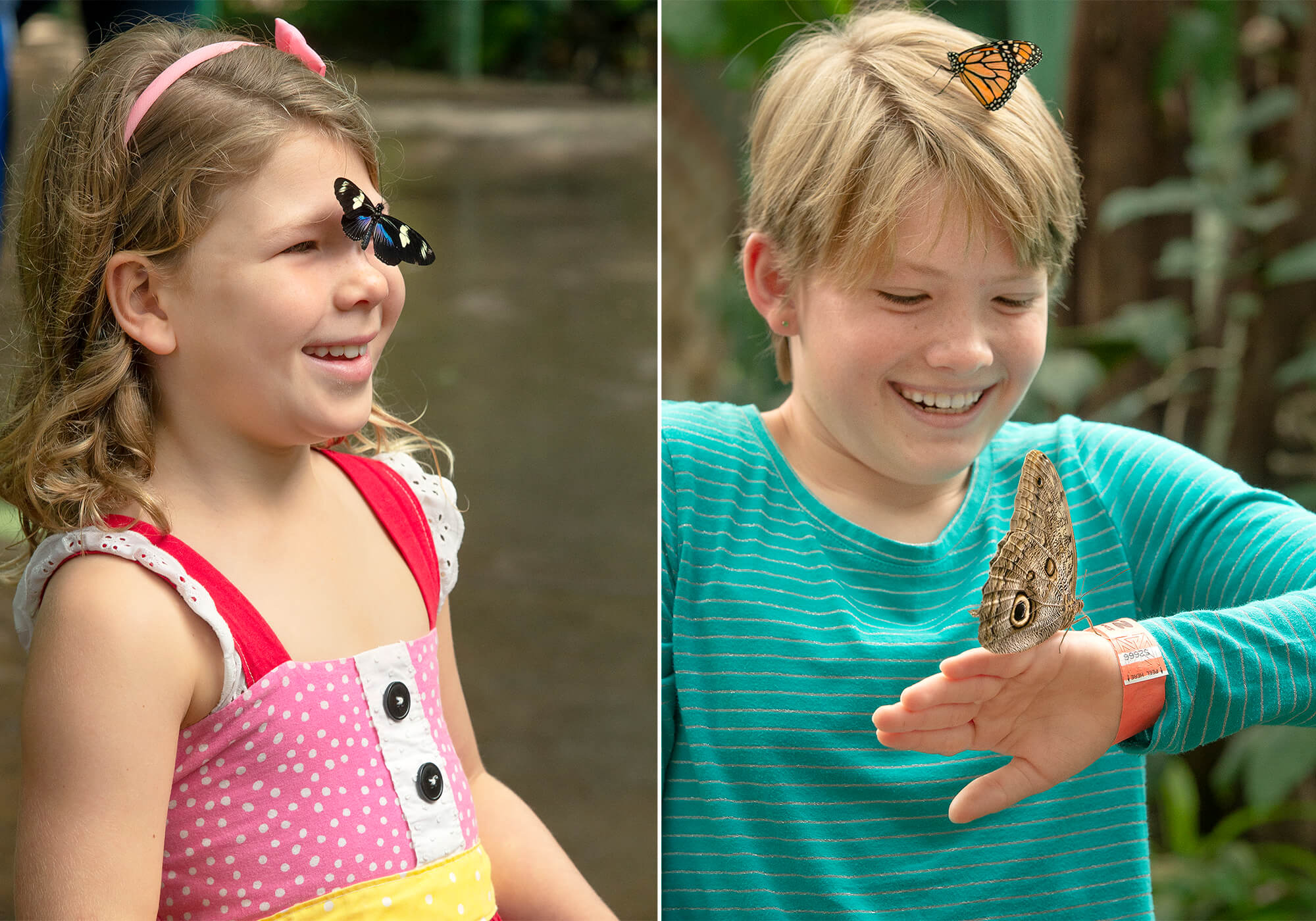
HITCHHIKERS
Visitors wearing bright colors may find themselves attracting butterflies! Keepers and exhibit attendants take special care to make sure that none of the “friendlies” hitch a ride out of the biologically secure exhibit.
Josie says her favorite part of Butterfly Jungle is the joy that the butterflies bring—to kids and adults. “It’s funny, because you have these kids who absolutely don’t want bugs landing on them at any other time of the year. The same kids walk into Butterfly Jungle, and if a butterfly lands on them, they are thrilled. If we can provide that kind of joy and teach them something at the same time, then we’re doing our job.”

